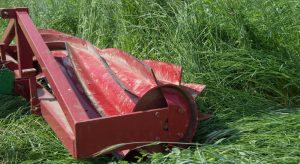Study calls for technology combining roller crimping and flaming for cover crops
 Photo credit: Rodale Institute
Photo credit: Rodale Institute
A recent study published in the Journal PlosǀOne found that the most effective strategy to terminate cover crops in systems where herbicides are prohibited or reduced is a combination of roller crimping and flaming. Before crops can be planted to follow cover crops, the cover crop has to be terminated and turned back into the soil. In conventional systems, herbicides are used to kill and deteriorate cover crops without tilling. Herbicides have known consequences on soil structure and soil microbial life, and are prohibited in organic farming. Organic farming systems have to use other methods to knock back and incorporate cover crops before planting cash crops, and ideally, reduced tillage is preferred. This study measured the effectiveness of roller crimping (a method that flattens and crushes the cover crop) and flaming (a method that applies intense heat to kill plants and is often used for weed control) in terminating cover crops. No one system of either roller crimping or flaming effectively terminated the fall-sown cover crop of winter pea and barley. The combination of the two methods resulted in the greatest suppression, at 85%. The authors suggest the most important finding was that the combination of methods shortened the time needed to break down the cover crop into mulch without tilling. The study calls for more research to identify ways to overcome the price barrier of using the flaming technique, and suggests that developmental efforts should put into technology that combines flaming and crimping into one machine as a potential solution.


